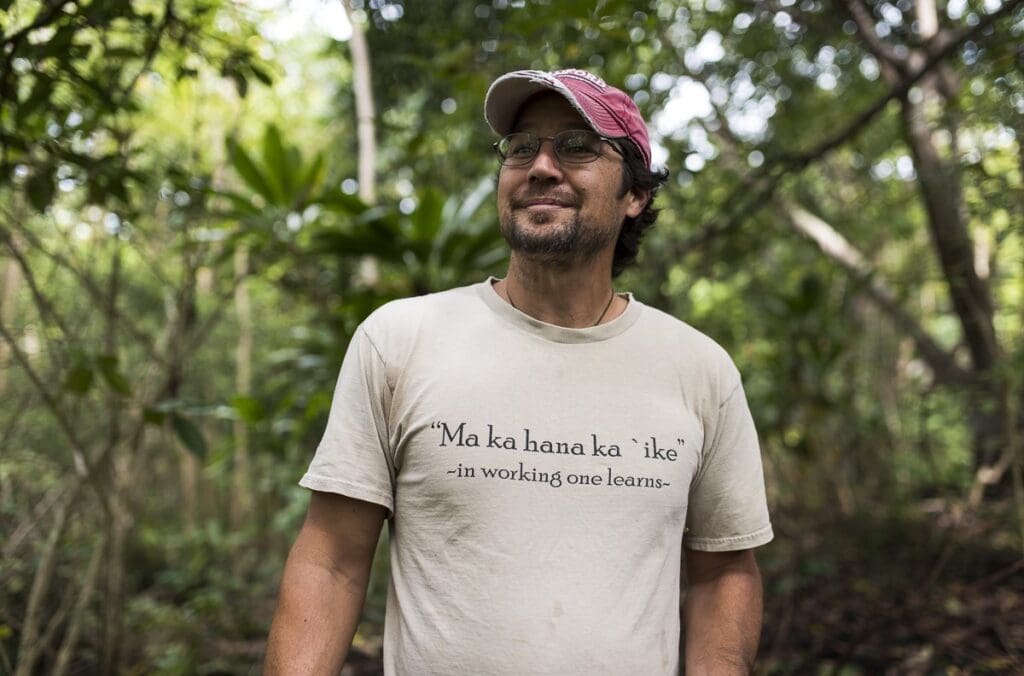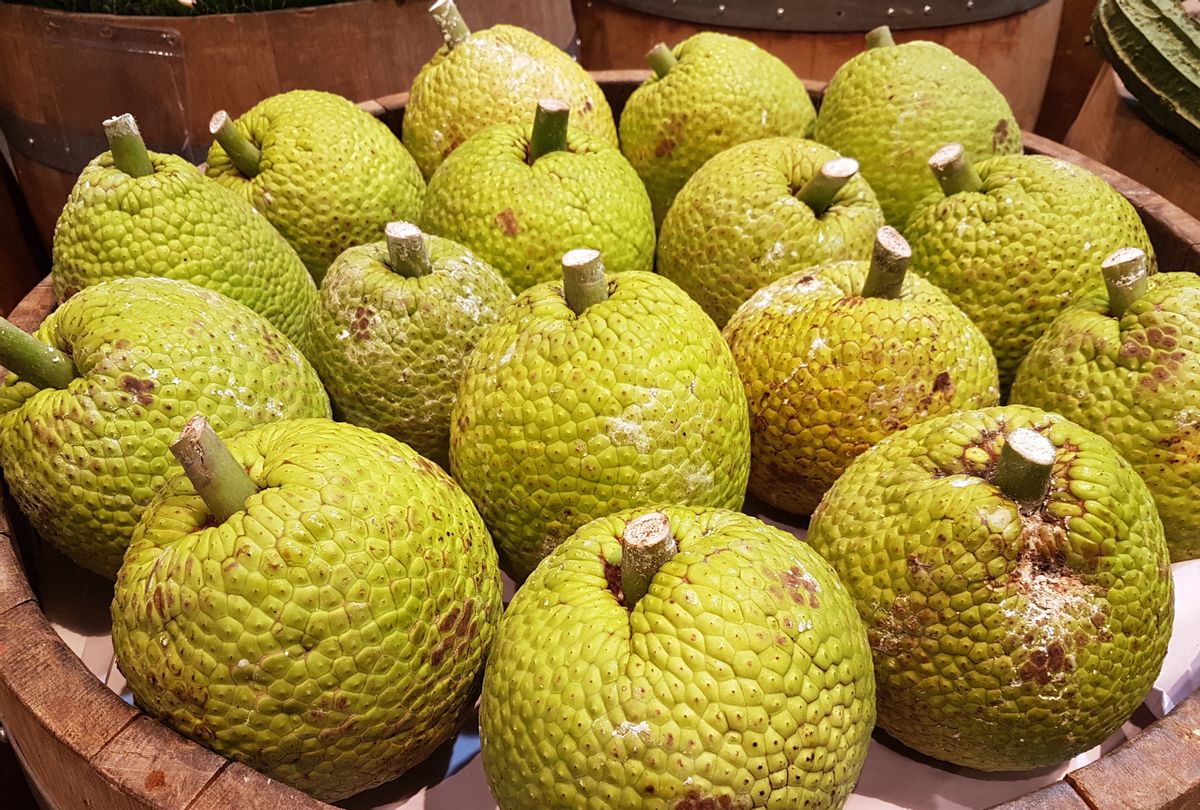Centuries before the historic West Maui fire of August 8, 2023, Lahaina was a lush and breezy coastal flat of utopian-level food productivity. Kalo (taro), the starchy root and central ingredient of the traditional Polynesian staple poi, sprouted heart-shaped edible foliage (luau) from wetlands irrigated by mountain streams. A jungle’s worth of niu (coconut) and ‘ulu (breadfruit) trees were laden with ripened drupes. A 17-acre spring-fed pond teemed with so many fish that a fresh catch required only a handnet. And on Moku‘ula, a small island in the middle of the water, stood a private residence of King Kamehameha III.
With this history in mind, it’s no surprise that many Hawaiians believe that they are living in a time of intense hulihia, or “turning” — a cosmological reckoning, if you will. Lahaina had been a paradise lost well before that fateful Tuesday, when a high-pressure system from the north converged with a hurricane-fueled low-pressure system from the south to unleash a wrath of wind and fire. By the mid 19th century, the town had become a rollicking port for whalers; around that time, wealthy European plantation owners, seeking tropical climes to grow pineapple and sugarcane, had set their sights on Maui. They decimated its native forests for plantations, and after felling Lahaina’s famed ‘ulu trees became illegal, they circumvented the law by burning them down instead. Pasturelands had begun replacing the mid-elevation forests of the West Maui Mountains as early as 1793, when an English naval explorer introduced six head of cattle to the islands.
This disrupted more than just the traditional systems of food production. Noa Kekuewa Lincoln, a University of Hawai‘i professor studying Indigenous crops and cropping systems, tells of the fabled maunalei, a cloud ring that once encircled the mountaintops around the island archipelago, providing cooling and nourishment for soil health and plant life — also known as evapotranspiration. “The disappearance of that phenomenon happened when those slopes were deforested,” he says.
Lorenzo Lyons, an early missionary, also noted changing winds over a more than 50-year period during the 19th century. “Cattle destroying the forest has changed the mumuku,” he wrote of the powerful gales that blow across the mountain ridges toward the ocean, which occurred more infrequently.
The six inaugural bovines have since multiplied into approximately 140,000 head state-wide, making cattle commerce in Hawai’i worth about $48 million annually. The plantation industry, however, once all-powerful across the archipelago, has dried up within the last decade, leaving in its wake plains of degraded soil from centuries of undiversified cultivation, or monocropping. Though Pu’u Kukui, the highest peak in the West Maui Mountains, remains one of the rainiest locations on the planet, the once-flourishing mid-elevation hillsides are droughted and eroding. Guinea grass, molasses grass and buffelgrass, nonnative plants brought in for cattle grazing, now pervade the pasturelands and the former plantation fields — and were among the 18 invasive species identified by the U.S. Department of Agriculture more than a decade ago as wildfire threats for Hawai‘i. Characteristically dry and fast-growing, this foreign vegetation turned out to be kindling for August’s fatal blaze.
In the aftermath, many are taking stock of how the land is being used, on Maui and across the islands. More than ever, the ongoing work of Indigenous farmers to revitalize traditional agriculture is in the spotlight.
Seeing possibility in Indigenous food systems
While climate change escalates the likelihood and intensity of wildfires, the same goes for hurricanes. If a category 5 tropical cyclone shuts down Hawai’i’s main port, Honolulu Harbor, which receives 1.1 million tons of food imports annually, there would be just five to seven days’ worth of commercial sustenance to feed residents and visitors on the islands. Since 85 to 90% of the state’s food production is outsourced, leaving massive swaths of unused agricultural lands susceptible to harmful grasses, Hawai‘i is doubly vulnerable to climate change and interruptions to its food supply. But 7,500 small farms, which comprise more than 95% of Hawai‘i’s agricultural sector, are working to secure the state’s fragile food sovereignty.
With the current food system so flawed, a small minority of those farms have attempted a return to Hawai’i’s pre-colonial era — that is, before first contact with the Europeans was made in 1777 — by using Indigenous farming methods like lo‘i (flooded wetland), mala (sunny and rainfed dryland farming) and agroforestry (a multi-story, multi-species food-production system that incorporates trees) to cultivate traditional Hawaiian foods. These include ‘ulu, niu, and kalo, a few of the two dozen tropical “canoe plants” that the first Polynesians brought with them when they settled Hawai’i between 1000 and 1200 AD.
“We’ve gone from totally surviving off these plants to importing most of our food,” says Lehia Apana, cofounder of Polipoli Farms, an agroforest in Waiehu, on Maui’s north shore. “We’ve drifted way off course.” According to a study published in Nature Sustainability, Hawai’i’s pre-colonial food production would be enough to sustain its current population. By contrast, modern-day food production on the islands — approximately 151,700 tons per year — is likely only a fraction of what native Hawaiians were producing before 1777. Indigenous farming practices have a proven track record of upholding Hawai’i’s food security.

Lehia Apana and Brad Bayless, founders of Maui’s Polipoli Farms, harvest native ‘ulu, or breadfruit. Photo courtesy of Polipoli farms.
Not only are agroforests an archetype of regenerative farming, needing little to no pest controls or fertilizers or any other aggressive technologies that would harm, rather than nurture, the soil, but they can also triple the amount of plants in an equivalent area of monoculture. Agroforestry’s natural biodiversity creates healthy soil that produces nutrient-dense food and sequesters more carbon to mitigate climate change than any old sugar or pineapple plantation. Other traditional approaches to agriculture have their own climate benefits: “Lo‘i do a lot to support a resilient ecosystem,” says Lincoln of how the wetlands recharge aquifers, reduce flooding potential and enhance evapotranspiration.
“Indigenous agriculture, not just in Hawai‘i, but globally, is being recognized for its ability to procure food, fiber and fuel while preserving the integrity and function of ecosystems,” the professor continues. “With the growing recognition of industrial farming’s ecological impacts and the increasing manifestation of climate change, we’re seeing more interest in understanding how Indigenous agricultural systems have persisted over millennia without harming the earth.”
Apana and her husband, Brad Bayless, both born and raised on Maui, began tending their agroforest from a three-acre plot of unruly jungle in 2018. In its plushest, most prolific pocket, ‘ulu trees, with their large, glossy-green leaves outstretched, hold court. The endemic māmaki shrub grows in sun-dappled spots around the ‘ulu. The long, oar-shaped foliage of mai‘a (banana) and the spear-like leaves of kō (sugarcane) eventually turn into nutrient-rich leaf litter that keeps the soil moist and healthy. In a modern twist, the farmers plant a cover crop of fast-growing sunn hemp, buckwheat and pigeon pea, which grow quickly to provide shade, nitrogen-fixation, nematode control and “chop-and-drop” material to fortify a fertile forest floor.
Some Indigenous farmers prefer even less intervention, eschewing cover crops and tilling in favor of a rich composting program and the traditional observance of lunar cycles to determine times of planting and harvesting. Owing to the thick canopy and the remarkable ability of trees to absorb heat, food forests are refreshingly climate-controlled places to farm, compared to sunbaked plantations. Bayless would know: He spent his teenage years working in Maui’s pineapple fields. “This is agriculture?” he thought. “No thanks.”
Colonial legacies persist
In 2016, Alexander & Baldwin, one of the Big Five (a conglomerate of corporations that controlled Hawai’i’s economy and politics for much of the 19th and 20th centuries), shut down Maui’s last sugar plantation, which had been illegally diverting tens of billions of gallons of water per year to the detriment of small farms. But even though the once-dominant plantation industry is now defunct, outside industrial agriculture interests still persist in Hawai’i through GMO enterprise and other agricultural development by wealthy off-island investors that threatens to displace traditional methods and homegrown farmers.
Biotech seed companies like Monsanto (which was absorbed by chemical giant Bayer in 2018) have longstanding island operations, at times criminal due to illegal pesticide use. These global agrochemical corporations could arguably be considered the 21st-century counterparts to 19th-century plantationers, since they are drawn to Hawai’i’s year-round growing environment and engage in farming practices that harm the natural world while profiting off of land that is not theirs. Approximately 90% of the GMO corn grown in the U.S. was developed on Kaua‘i, in the chemically sterilized soil required for such testing. “Hawai’i [has hosted] more than 2,230 field trials of genetically modified crops…more than any other state,” according to Scientific American.

Noa Kekuewa Lincoln, professor of Indigenous crops and cropping systems at the University of Hawai’i, was a founding member of the Hawai‘i ‘Ulu Cooperative. Photo courtesy of Noa Kekuewa Lincoln.
“Now with no money coming in through plantations, there’s no political motivation to use those ag lands to provide opportunities for other agriculture to fill the void,” explains Lincoln. Instead, development with high-revenue potential takes priority, and local agriculture gets the short end of the stick — less than 1% of the state’s annual budget.
Alexander & Baldwin sold 41,000 acres of its former Central Maui plantation lands to a Canadian pension fund, which started a “sustainable and diversified” agricultural venture called Mahi Pono in 2018. So far, it’s proven to be a complicated and controversial enterprise for many reasons, not least of which include the aggressive acquisition of water rights and a reportedly export-heavy business plan. Nevertheless, Mahi Pono, now Maui’s largest landowner, has planted 1.8 million citrus, avocado, macadamia, ‘ulu, coffee and coconut trees to date. By the end of this year, 2.3 million pounds of row crops like kale, lettuce, sweet onions, watermelon and pumpkins will have been harvested, with an undisclosed percentage slated to stay in Hawai‘i. Since 2020, Mahi Pono has also been the majority owner of Maui Cattle Co.
While Lincoln declined to comment on outside companies like Mahi Pono or the California-headquartered Sensei Farms, tech titan (and Hawai‘i transplant) Larry Ellison’s large-scale hydroponic agricultural system on Lāna‘i, he did express concern over their vertically integrated business models in a February 2020 op-ed. “Mahi Pono and Sensei Farms are large enough that, presumably, they will handle all aspects of the food chain,” he wrote. “Not only will they grow and harvest the food, but also chill, process, market and distribute that food as a necessary path to market.” These setups, Lincoln says, have been attractive to Hawai‘i’s government because they require little state support, unlike small farmers for whom much of this infrastructure is out of reach. As he puts it, this kind of “‘local food’ does not necessarily mean locals benefit.”
Lincoln makes a case for local food hubs, which help navigate that labyrinthine infrastructure for the small farms that wouldn’t otherwise be able to organize or afford widespread distribution of their hard-earned harvest. Today, there are 14 food hubs across the state, including Hawai‘i ‘Ulu Cooperative, of which Lincoln and his wife Dana Shapiro — who also own a small ‘ulu farm in Kona on Hawai‘i island — are founding members. “Food hubs provide a social and cultural network of collaboration and organization that is really, really critical for small farmers to contribute to a sustainable food system,” Lincoln tells FoodPrint. “Even today, people say that we couldn’t feed the world without industrial farming. But that’s kind of b.s. Most of the world is still fed by smallholder producers.”
Indigenous foodways take on new urgency
Growing up, traditional foods were not part of Apana’s family table, a fairly common plight of Indigenous people whose cultural customs are often forcibly erased or eclipsed by the technological temptations of modern society. Not only does she claim Chicken McNuggets as a childhood staple, she remembers only eating traditional Hawaiian food at baby showers and graduation parties. Producing a Polipoli pantry — a line of shelf-stable packaged foods made from the agroforest crop — is Bayless and Apana’s way of increasing accessibility of traditional Hawaiian ingredients to locals.
In the aftermath of the Lahaina blaze, ancient Hawaiian customs from ceremonial chanting to Indigenous foods have been even stronger spiritual touchstones for the community. Many even believe that Lahaina’s scorched earth provides a rare opportunity to restore the town’s ancient ‘ulu trees, underscoring the value of traditional subsistence. “I would very much like to see that deeper history honored in what is eventually revived,” says Lincoln.
When three Lahaina shops that sold Polipoli Farms pantry goods were destroyed in the fire, the Maui Hub, born of the pandemic, intervened to help Apana and Bayless supply their chewy banana snacks and māmaki-‘ulu loose-leaf tea to three other islands. “What happened in Lahaina will always be an epic reminder that community brings resiliency,” says Apana. To that end, a new Maui Food Innovation Center opened in November, just in time to aid fire recovery by improving food security through the development of local “farm-to-shelf” products. According to Honolulu Civil Beat, “the lack of facilities for value-adding agricultural products is seen as a key chokepoint in Hawaii’s food supply chain,” and the center will help farmers “take the risk out of trying to scale a business.”
Kealoha Domingo, chef-founder of O‘ahu-based catering company Nui Kealoha, admits that he grew up eating poi from a plastic bag and “didn’t really know anything about being Hawaiian” until he reached adulthood. As a kind of course correction for the soul, he’s dedicated his cooking career to helping people see the complete picture of Hawaiian food. He now pounds poi in the traditional way, foremost to set an example for his three sons, part of the next generation of stewards for the Hawaiian culture.
“The most important thing for me is connecting Hawaiian people spiritually and culturally to the food that sustains them,” says Domingo. “I help them understand how the food got to the table and why it’s there.” That includes passing over limited resources like opihi (blackfoot limpet) and oio (bonefish) for more abundant ingredients: His trademark dishes include ‘ulu poke and lawalu fish poached in coconut water.
Many of the problems underlying August’s landmark fire persist throughout the Hawaiian Islands. Domingo has also been able to witness the impacts of climate change on agriculture firsthand: His commercial kitchen is located on Kāko‘o ‘Oīwi, an ‘ulu farm and lo‘i kalo in Kāne‘ohe, O‘ahu and he is also part-owner of an agroforestry enterprise. “It’s mid-October, and to my memory, ‘ulu season should be wrapping up by now,” he told FoodPrint. “But I noticed some fruit on the trees two days ago that are at least a month out from being ready. The seasons are definitely pushing.” As for kalo, he attests that the local supply doesn’t meet local demand — Hawai’i imports 2 million pounds of the staple food from Fiji per year — and envisions a return to self-sufficiency. “I personally think everyone should be growing kalo,” he says.
Whether traditional Hawaiian farming will ever look exactly like it did centuries ago remains to be seen. Though interest continues to gain momentum in the wake of the Lahaina tragedy, Bobby Pahia, a dryland kalo farmer on Maui, believes that innovations in agricultural technology may have obscured some important cultural practices in the process. After all, one or two high-tech machines will do the work of hundreds of collaborative hands in the field. The Hawaiian art of kilo, or keen environmental observation, has been usurped by newfangled instruments that can determine weather and soil conditions with the push of a button.
Still, Pahia hopes that the ancient Hawaiian law of kānāwai, which encourages everyone to help and protect each other, isn’t irretrievably broken. “The motive of traditional farming was different back then,” he says. “It was a kako‘o: a ‘we’ thing, a village concept.” With that hulihia — that turning — in motion, it’s possible that ancient ways are cycling through once again.


Shares